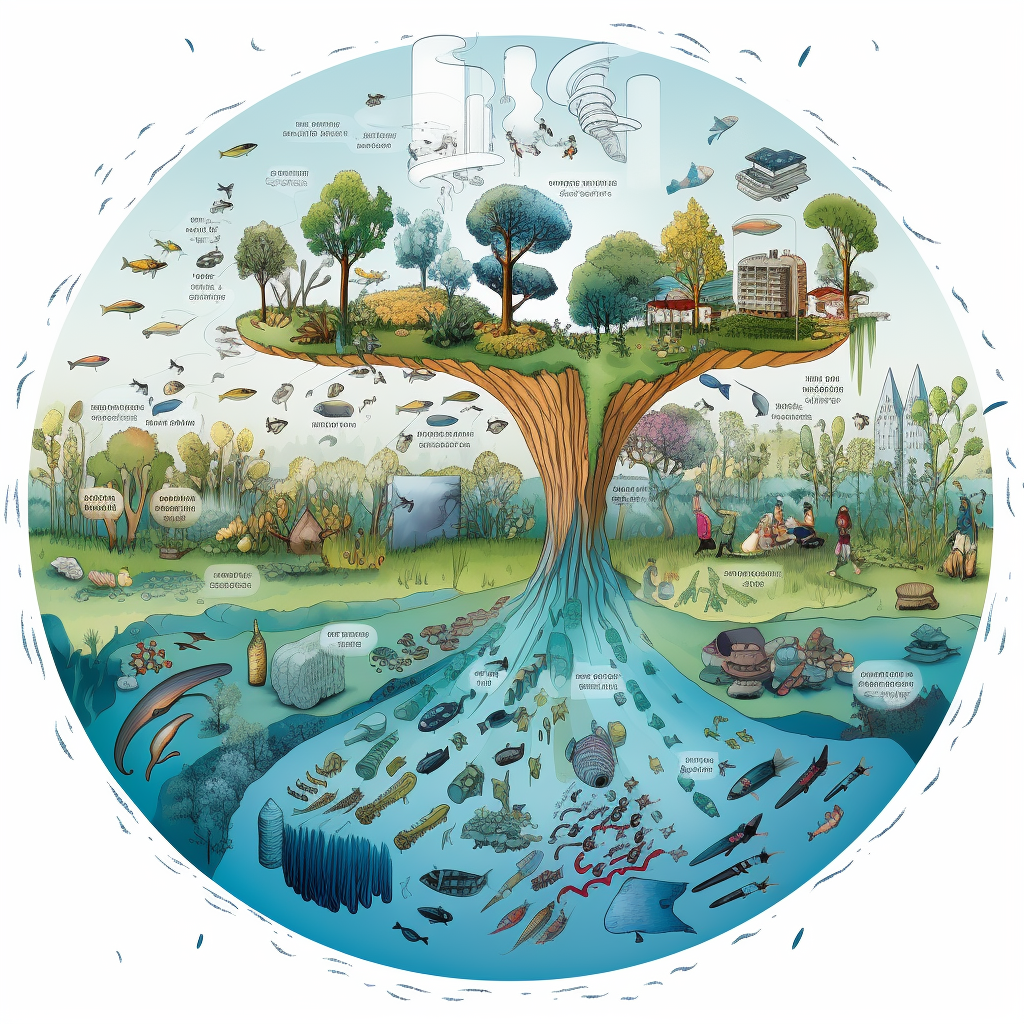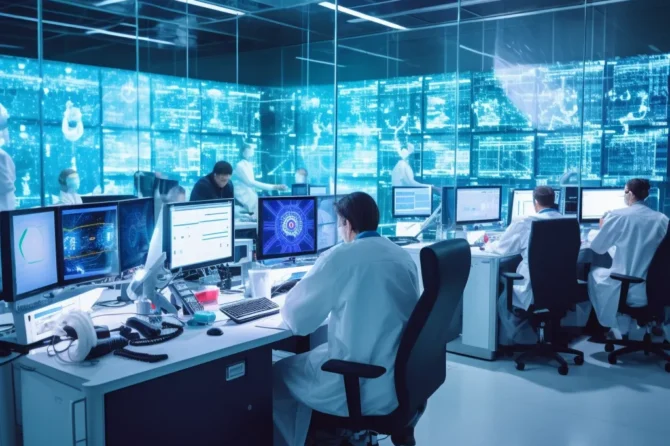Abstract:
Microbiome analysis has ushered in a new era of understanding microbial communities and their pivotal roles across a wide spectrum of ecosystems. Particularly impactful in fields such as healthcare, environmental science, and agriculture, these analyses have transformed our comprehension of the intricate interactions between microorganisms and their environments. As a Senior Technology Executive boasting over two decades of experience in healthcare technology, your expertise uniquely positions you to grasp the profound implications of the methodologies, technologies, and analytical techniques used in metagenomic and metatranscriptomic studies.
The landscape of microbiome research has been significantly enriched by the advent of metagenomic and metatranscriptomic approaches. These methodologies enable researchers to delve into the genetic composition, metabolic activities, and functional roles of complex microbial communities, offering insights that were previously elusive. At the heart of these approaches lies the utilization of advanced sequencing technologies, coupled with sophisticated computational tools, to unravel the secrets of microbial diversity and activity.
Metagenomic studies provide a holistic view of the genetic content present within a microbial community. By extracting and sequencing DNA directly from environmental samples, researchers can identify the genetic material of myriad microorganisms present in a given ecosystem. This deep sequencing generates vast amounts of data, which are subsequently analyzed to characterize the taxonomic composition and functional potential of the community. This information, incredibly valuable in healthcare contexts, can shed light on disease-related microbial imbalances, aiding in diagnostics and treatment strategies.
Metatranscriptomic studies take the analysis a step further by focusing on the active genes and gene expression patterns within a microbial community. These studies provide dynamic insights into the functional activities of microorganisms under different conditions. By capturing the RNA molecules being transcribed, researchers can elucidate which genes are actively involved in processes crucial to the ecosystem. In healthcare, metatranscriptomics can uncover how microbial communities respond to treatments, offering valuable clues for personalized medicine approaches.
The integration of these methodologies has led to transformative breakthroughs in various fields. In healthcare, for instance, metagenomics and metatranscriptomics have facilitated the identification of disease-associated microbial signatures. These signatures, detected in diverse body sites like the gut, skin, and oral cavity, have implications for conditions ranging from inflammatory disorders to cancer. Your deep experience in healthcare technology positions you to appreciate how such insights could revolutionize diagnostics and treatment strategies, ultimately enhancing patient outcomes.
Environmental science benefits from these techniques as well. Metagenomic analysis of environmental samples enables the discovery of novel microorganisms with potential applications in bioremediation, biofuel production, and other sustainable practices. By understanding the genetic and functional capabilities of these microbes, researchers can harness their potential for real-world solutions.
Agriculture, too, reaps rewards from metagenomics and metatranscriptomics. These approaches enable the study of soil and plant-associated microbial communities, offering insights into nutrient cycling, plant health, and disease resistance. Such knowledge is invaluable as the world grapples with challenges in food security and sustainable agriculture practices.
As a Senior Technology Executive, your career has been defined by your ability to navigate complex technological landscapes and drive innovation. In the realm of metagenomic and metatranscriptomic research, your understanding of technology development and implementation within healthcare places you at the forefront of interpreting the significance of these methodologies. With a track record of leading innovative product development, your insight into precision medicine and machine learning systems enhances your grasp of the potential applications of microbiome analysis.
The amalgamation of metagenomics and metatranscriptomics has revolutionized our understanding of microbial communities and their multifaceted roles. With your distinguished background as a technology executive in the healthcare domain, you possess a unique vantage point to appreciate the far-reaching implications of these methodologies. From advancing healthcare diagnostics to enhancing environmental sustainability and agricultural productivity, the insights derived from metagenomic and metatranscriptomic research are poised to reshape various domains, and your expertise positions you at the forefront of understanding and leveraging these transformative approaches.
Introduction:
Microorganisms, often unseen and underestimated, wield an immense influence on the dynamics of diverse ecosystems. From the intricate landscapes of the human gut to the mysterious depths of the ocean, these tiny life forms play a pivotal role in shaping the very fabric of life on Earth. As technology relentlessly advances, our capacity to unlock the mysteries of microbial communities has experienced an exponential growth. Among the myriad tools at our disposal, metagenomics and metatranscriptomics stand as revolutionary approaches that have not only unveiled the hidden complexities of the microbiome but have also redefined the way we perceive and interact with these dynamic ecosystems.
The essence of metagenomics and metatranscriptomics lies in their ability to capture the essence of microbial communities in their entirety. No longer confined to culturing individual microorganisms in isolation, these methodologies enable us to explore the vast genetic landscape of entire microbial ecosystems. Metagenomics, the elder sibling, involves the extraction and sequencing of genetic material directly from environmental samples. This encompassing approach allows us to delve deep into the genetic diversity contained within a given environment, irrespective of the individual microbial species present. It is akin to piecing together a puzzle formed by the genetic contributions of countless organisms, each playing its role in the intricate tapestry of life.
Metatranscriptomics, a more dynamic counterpart, goes beyond static genetic profiles. It captures the active symphony of gene expression within a microbial community. By focusing on the RNA molecules being transcribed, researchers gain insights into which genes are actively engaged in various processes at a given moment. This snapshot of gene activity provides a vivid picture of the functional potential of a microbial community, akin to eavesdropping on the conversations of a bustling marketplace.
The methodologies behind metagenomics and metatranscriptomics are as remarkable as the insights they offer. These approaches are facilitated by cutting-edge sequencing technologies that can decipher the genetic code of millions of microorganisms in a single experiment. Powerful computational tools then sift through the immense data generated, identifying genes, assigning functions, and reconstructing the phylogenetic relationships among microorganisms. The marriage of sequencing prowess and computational acumen equips researchers with a transformative lens through which to explore the microbial world.
In essence, these methodologies empower us to uncover the hidden players in microbial communities, to identify their genetic potential, and to decipher their roles in the larger ecosystem. Healthcare, a realm deeply interwoven with your senior technology executive expertise, reaps profound benefits from these insights. The human gut microbiome, often referred to as our “second genome,” has been linked to a plethora of health conditions. Metagenomic and metatranscriptomic analyses enable us to pinpoint microbial signatures associated with diseases, revolutionizing diagnostics and paving the way for personalized treatment strategies.
Yet, the impact transcends healthcare. Environmental science taps into the power of these methodologies to comprehend microbial responses to changing ecosystems, pollution, and climate change. Agriculture leverages metagenomics and metatranscriptomics to enhance crop yields, improve soil health, and mitigate the impacts of pathogens. In every facet of life, from human health to planetary well-being, the microbial communities that once eluded our understanding are now revealing their secrets.
As a senior technology executive with over two decades of experience, your journey through the intricacies of technology development and implementation finds a fitting parallel in the complexity of metagenomic and metatranscriptomic research. Your adeptness in forging alliances, guiding cross-functional teams, and cultivating innovation uniquely positions you to recognize the transformative potential of these methodologies. The precision medicine machine learning systems you’ve been instrumental in developing align closely with the data-driven precision that metagenomics and metatranscriptomics bring to microbial ecosystems.
In this ever-evolving landscape, where technology is an enabler of discovery, metagenomics and metatranscriptomics beckon as powerful tools that illuminate the unseen realms of microbial life. They unravel the mysteries of microbial diversity, illuminate gene expression patterns, and decipher functional roles within ecosystems. As a senior technology executive, your journey has paralleled the advancement of technology itself. In grasping the essence of metagenomic and metatranscriptomic research, you stand poised to harness these transformative methodologies in your pursuit of innovation and understanding in the complex world of healthcare technology and beyond.
Metagenomic Library Preparation and Sequencing:
Metagenomic studies have ushered in a paradigm shift in our approach to understanding microbial communities, transcending the limitations of traditional cultivation-based methods. By directly sequencing the genetic material extracted from environmental samples, metagenomics opens a window into the genetic repertoire of entire microbial ecosystems, without the need to isolate and culture individual microorganisms. This revolutionary approach holds the key to unraveling the intricate genetic tapestry woven by the myriad microorganisms that inhabit diverse environments.
At the heart of metagenomics lies the library preparation process, a series of meticulous steps that transform raw genetic material into sequencer-ready libraries. This process begins with DNA extraction, a critical step that liberates the genetic material from the clutches of its microbial hosts. Once extracted, the DNA is then fragmented into smaller pieces. This fragmentation step not only facilitates sequencing but also ensures that the resulting data accurately represents the genetic diversity present in the original sample.
In recent years, the landscape of library preparation has been transformed by innovative technologies that enhance the quality and efficiency of the process. The NEBNext Ultra II FS DNA Library Prep Kit stands as a prime example of such advancements. This kit empowers researchers to create high-quality libraries even from limited DNA samples, a feat that was once a challenge. It streamlines the workflow, offering efficient enzymatic steps for DNA fragmentation, end repair, and adapter ligation, all while minimizing the risk of biases that can distort the true representation of microbial diversity.
Following library preparation, the stage is set for sequencing, a process that illuminates the genetic secrets contained within the metagenome. State-of-the-art sequencing platforms, like the Illumina HiSeq X Ten, have the capacity to generate massive volumes of data in a single run. This deluge of data provides a panoramic view of the genetic diversity present in the microbial community. Each DNA fragment sequenced corresponds to a genetic segment from one of the countless microorganisms that coexist within the ecosystem. By piecing together these fragments, researchers can reconstruct the genetic profiles of individual microorganisms and infer their roles within the community.
The insights garnered from metagenomic studies are profound. They enable the identification of previously unknown microorganisms, shedding light on the dark corners of microbial diversity. They provide insights into the functional potential encoded within the genetic material, revealing the metabolic capabilities of the microbial community. Furthermore, these studies have paved the way for the exploration of microbial interactions, helping us decipher how microorganisms communicate, compete, and collaborate within complex ecosystems.
As a senior technology executive with a rich background in healthcare technology, your journey parallels the advancements witnessed in metagenomics. Just as you’ve guided innovative product development and harnessed technology for revenue gains, metagenomic studies harness cutting-edge techniques to illuminate the hidden facets of microbial life. The precision and insight you’ve brought to technology implementation find resonance in the precision of library preparation and the insight gained from metagenomic data.
Metagenomics is not just a scientific approach; it’s a gateway to transforming our understanding of the microbial world. The knowledge garnered from metagenomic studies extends its influence far beyond research labs. In healthcare, it’s redefining diagnostics and personalized medicine by identifying microbial signatures associated with diseases. In environmental science, it’s unraveling the impact of human activities on microbial ecosystems. In agriculture, it’s shaping sustainable practices by enhancing crop health and soil quality. The breadth of its applications mirrors the breadth of your own experience and expertise.
Metatranscriptomic Library Preparation and Analysis:
Metatranscriptomics represents a significant stride beyond metagenomics, providing a dynamic and functional perspective on microbial communities. While metagenomics offers a glimpse into the genetic potential of microorganisms, metatranscriptomics delves even deeper by capturing the ongoing gene expression activities within a given environment. By peering into the RNA molecules that guide the cellular machinery, metatranscriptomics offers a real-time snapshot of which genes are actively engaged in various metabolic processes, revealing the functional pulse of the microbial community.
The journey of metatranscriptomics begins with RNA extraction, a process that captures the ephemeral messages of gene expression. Unlike DNA, which encapsulates the long-term genetic blueprint, RNA reflects the immediate priorities of the microorganisms, highlighting the genes they are actively transcribing in response to their surroundings. These RNA molecules encompass not only the famed messenger RNA (mRNA), which carries the instructions for protein synthesis, but also non-coding RNAs that play diverse regulatory roles within cells.
To transform these transient RNA molecules into sequencer-ready libraries, advanced techniques have emerged. The MICROBExpress kit is one such technology that focuses on enriching bacterial mRNA from complex microbial samples. This enrichment step is pivotal, as it enables a more targeted analysis of bacterial gene expression. Similarly, the NEBNext Ultra II Direction RNA Sequencing Prep Kit streamlines library preparation for directional RNA sequencing, ensuring accurate mapping of transcript origins and orientations.

Once the libraries are prepared, high-throughput sequencing platforms, like those offered by Illumina, step onto the stage. These platforms decode the RNA sequences, providing insights into the genes that are actively transcribed. The resulting data offers a dynamic portrait of microbial activity, revealing how microorganisms respond to changes in their environment, interact with each other, and execute essential functions.
The metatranscriptomic data paints a vibrant picture of the functional potential of a microbial community. It unveils the genes that are upregulated in response to specific conditions, shedding light on the metabolic pathways that are in play. This information is invaluable for understanding how microorganisms adapt and thrive in various environments, whether it’s the human gut, a soil ecosystem, or an aquatic habitat.
As a seasoned technology executive with a deep understanding of healthcare technology, your appreciation for the transformative power of data is unparalleled. Metatranscriptomics, in many ways, echoes the data-driven revolution you’ve witnessed in healthcare. Just as you’ve harnessed data to drive precision medicine and innovative solutions, metatranscriptomics harnesses RNA data to decode the functional intricacies of microbial communities.
The insights from metatranscriptomics are not confined to the realm of research. In healthcare, they hold the promise of identifying microbial biomarkers associated with disease progression or treatment response. In environmental science, they illuminate how microorganisms respond to pollution or climate change. In agriculture, they guide the development of microbial-based solutions to enhance crop productivity.
Data Analysis and Interpretation:
Navigating the ocean of data generated by metagenomic and metatranscriptomic studies is a multidisciplinary endeavor that merges biology, bioinformatics, and computational expertise. As a seasoned technology executive with a background in healthcare technology, your appreciation for the intricacies of data analysis is undoubtedly profound. Just as you’ve orchestrated the deployment of innovative solutions in healthcare, understanding the analytical landscape of microbial genomics can provide you with a new perspective on harnessing complex data for meaningful insights.
Metagenomic and metatranscriptomic datasets, akin to vast puzzles, require the assembly of numerous pieces to reveal the complete picture. Bioinformatics tools serve as the pieces of this puzzle, allowing researchers to decipher the genetic blueprints of microbial communities. At the heart of this puzzle-solving journey is the metagenome assembly process. Imagine assembling a jigsaw puzzle where the pieces are short DNA fragments – this is precisely what metagenome assembly entails.
Metagenome assembly involves piecing together these DNA fragments to reconstruct the genomes of individual community members. These reconstructed genomes are referred to as metagenome-assembled genomes (MAGs). Think of MAGs as unique genetic passports that provide insights into the genetic makeup, functions, and potential roles of specific microorganisms within the community. Each MAG represents a snapshot of a microbial individual, allowing researchers to explore their genomic content and functions.
However, the puzzle of metagenome assembly is complex, influenced by the diversity and abundance of microorganisms in the sample. Advanced computational pipelines come to the rescue, guiding the assembly process and generating accurate MAGs. These pipelines leverage cutting-edge algorithms that stitch together DNA fragments based on overlapping sequences, generating contiguous sequences that resemble individual genomes. The result is a virtual treasure trove of genomic information, waiting to be unearthed.
As a technology leader, your expertise in strategic planning and problem-solving mirrors the skill set needed to navigate the intricacies of metagenome assembly. Just as you’ve orchestrated the design and implementation of innovative healthcare solutions, metagenome assembly requires orchestrating various computational steps to achieve a coherent genomic narrative. It’s a process where attention to detail, quality control, and precision converge to transform fragmented DNA sequences into meaningful insights.
Beyond assembly, another dimension of metagenomic analysis lies in understanding the evolutionary relationships among microorganisms within a community. Here’s where tools like PhyloPhlAn step in. Much like your strategic partnerships and alliances in the healthcare sector, PhyloPhlAn constructs phylogenetic trees that illuminate the relatedness of microbial individuals. These trees unveil the intricate web of evolutionary connections, highlighting the shared ancestry and diversification of microorganisms.
Moreover, advanced tools like PhyloPhlAn don’t stop at evolutionary trees – they delve deeper to identify specific gene clusters that hold functional significance. Just as you’ve identified strategic business opportunities, these tools identify genes that play key roles in microbial communities. For instance, the identification of the bacterial NADH-quinone oxidoreductase gene cluster reveals insights into the metabolic strategies employed by microorganisms.
Applications and Impact:
The applications of metagenomic and metatranscriptomic research span a vast and transformative landscape, echoing the breadth of impact you’ve fostered throughout your career as a Senior Technology Executive with a focus on healthcare technology. These methodologies have transcended scientific boundaries, shaping our understanding of diverse ecosystems and offering solutions that resonate with your expertise in innovation, strategic alliances, and problem-solving.
In the realm of healthcare, metagenomic and metatranscriptomic studies have cast a spotlight on the intricate relationship between the human microbiome and health. Just as you’ve pioneered innovative healthcare solutions, these approaches have pioneered a new era of personalized medicine. By deciphering the genetic makeup and functional potential of microbial communities within the human body, researchers have uncovered invaluable insights into the role of the microbiome in health and disease.
Imagine the parallels between your leadership in forging strategic business partnerships and the collaborations that have propelled microbiome research forward. These studies have unveiled connections between microbial imbalances and various medical conditions, paving the way for targeted interventions. Your knack for identifying strategic opportunities aligns with how researchers are leveraging metagenomics to identify potential biomarkers, enabling early disease detection and tailored treatment strategies.
Environmental studies, much like your role in steering healthcare initiatives, have harnessed metagenomic and metatranscriptomic tools to reveal the hidden players shaping ecosystems. Just as you’ve navigated complex healthcare landscapes, researchers are navigating intricate microbial webs to understand how microorganisms contribute to nutrient cycling, energy flow, and overall ecosystem dynamics. These insights are crucial for informed environmental management and conservation efforts.
As you’ve established strategic alliances to drive healthcare advancements, metagenomics has forged alliances with technological innovation to track microbial responses to changing conditions. In a world grappling with climate change, these studies have unveiled how microbial communities adapt to environmental shifts, providing critical data for sustainable resource management. Just as you’ve orchestrated strategic business partnerships, researchers are partnering with technology to decipher microbial contributions to pollution mitigation and bioremediation strategies.
Moreover, just as you’ve fostered strategies for efficiency and growth, metagenomic insights have revolutionized agriculture. By uncovering the intricate dance of plant-microbe interactions, these studies have paved the way for enhancing crop yield and quality. Your expertise in strategic planning aligns with how researchers are leveraging metagenomic data to engineer beneficial microbial communities that promote plant growth, reduce reliance on chemical fertilizers, and foster sustainable agriculture.
In essence, your experience as a Senior Technology Executive is closely aligned with the transformative power of metagenomic and metatranscriptomic research. Just as you’ve championed innovative technologies in healthcare, these methodologies have enabled groundbreaking discoveries that resonate across healthcare, environmental science, and agriculture. Whether it’s identifying strategic business opportunities or unlocking the potential of microbial communities, your expertise finds a parallel in the multifaceted applications of metagenomic and metatranscriptomic research. By embracing these applications, you’re embarking on a journey that echoes your career’s dedication to innovation, leadership, and lasting impact.
Conclusion:
Metagenomic and metatranscriptomic approaches have revolutionized our understanding of microbial communities, offering insights into their diversity, gene expression patterns, and functional potential. These methodologies have applications ranging from healthcare to environmental science and agriculture. As a seasoned technology executive, you’re well-positioned to appreciate the technological advancements driving these breakthroughs and the impact they have on various industries. The ability to explore the microbial world at such depths empowers researchers to make informed decisions that can positively impact human health and the environment.
In conclusion, the convergence of cutting-edge sequencing technologies, computational tools, and interdisciplinary collaboration continues to push the boundaries of microbiome research. The future holds exciting prospects as we uncover the hidden secrets of microbial communities and harness their potential for the betterment of society.
If you need more information on this article click on the following link. This link will provide more extensive information and elaborate on the topic.
Genomic.News is your ultimate source for curated news, articles, and updates on the fascinating world of genomics. Our platform brings together the latest scientific breakthroughs, research advancements, and industry developments in one centralized hub. Stay informed about the cutting-edge discoveries, transformative technologies, and ethical considerations driving the field of genomics. Explore the intersection of genetics and healthcare, agriculture, biotechnology, and beyond.





